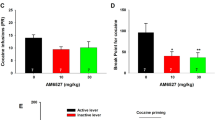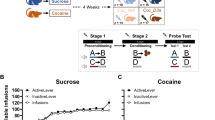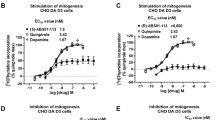Abstract
Vulnerability to the effects of drugs of abuse during adolescence may be related to altered incentive motivation, a process believed to be important in addiction. Incentive motivation can be seen when a neutral stimulus acquires motivational properties through repeated association with a primary reinforcer. We compared adolescent (postnatal day (PND) 24–50) and adult (>PND 70) rats on a measure of incentive motivation: responding for a conditioned reinforcer (CR). Rats learned to associate the delivery of 0.1 ml of 10% sucrose with a conditioned stimulus (CS; light and tone); 30 pairings per day were given over 14 days. Then, we measured responding on a lever delivering the CS (now a CR) after injections of amphetamine (0, 0.25 or 0.5 mg/kg). We also examined responding for CR when the CS and sucrose were paired or unpaired during conditioning, and responding for the primary reinforcer (10% sucrose) in control experiments. Finally, we examined the effects of D1 and D2 dopamine receptor antagonists (SCH 39166 and eticlopride, respectively) and an opioid receptor antagonist (naltrexone) on responding for a CR in adolescent rats. Adolescents but not adults acquired responding for a CR, but adolescents responded less than adults for the primary reinforcer. Responding for a CR depended upon the pairing of the CS and sucrose during conditioning. Both dopamine and opioid receptor antagonists reduced responding for the CR. Therefore, incentive motivation may be enhanced in adolescents compared with adults, and incentive motivation may be mediated in part by both dopamine and opioid systems.
Similar content being viewed by others
Log in or create a free account to read this content
Gain free access to this article, as well as selected content from this journal and more on nature.com
or
References
Aberg M, Wade D, Wall E, Izenwasser S (2007). Effect of MDMA (ecstasy) on activity and cocaine conditioned place preference in adult and adolescent rats. Neurotoxicol Teratol 29: 37–46.
Andersen SL, Thompson AT, Rutstein M, Hostetter JC, Teicher MH (2000). Dopamine receptor pruning in prefrontal cortex during the periadolescent period in rats. Synapse 37: 167–169.
Badanich KA, Adler KJ, Kirstein CL (2006). Adolescents differ from adults in cocaine conditioned place preference and cocaine-induced dopamine in the nucleus accumbens septi. Eur J Pharmacol 550: 95–106.
Barbano MF, Cador M (2007). Opioids for hedonic experience and dopamine to get ready for it. Psychopharmacology (Berl) 191: 497–506.
Beninger RJ, Ranaldi R (1992). The effects of amphetamine, apomorphine, SKF 38393, quinpirole and bromocriptine on responding for conditioned reward in rats. Behav Pharmacol 3: 155–163.
Berridge KC (1996). Food reward: brain substrates of wanting and liking. Neurosci Biobehav Rev 20: 1–25.
Berridge KC (2007). The debate over dopamine's role in reward: the case for incentive salience. Psychopharmacology (Berl) 191: 391–431.
Berridge KC (2009). ‘Liking’ and ‘wanting’ food rewards: brain substrates and roles in eating disorders. Physiol Behav 97: 537–550.
Berridge KC, Robinson TE (1998). What is the role of dopamine in reward: hedonic impact, reward learning, or incentive salience? Brain Res Brain Res Rev 28: 309–369.
Bolanos CA, Glatt SJ, Jackson D (1998). Subsensitivity to dopaminergic drugs in periadolescent rats: a behavioral and neurochemical analysis. Brain Res Dev Brain Res 111: 25–33.
Brenhouse HC, Sonntag KC, Andersen SL (2008). Transient D1 dopamine receptor expression on prefrontal cortex projection neurons: relationship to enhanced motivational salience of drug cues in adolescence. J Neurosci 28: 2375–2382.
Burns LH, Robbins TW, Everitt BJ (1993). Differential effects of excitotoxic lesions of the basolateral amygdala, ventral subiculum and medial prefrontal cortex on responding with conditioned reinforcement and locomotor activity potentiated by intra-accumbens infusions of D-amphetamine. Behav Brain Res 55: 167–183.
Burton CL, Nobrega JN, Fletcher PJ (2009). The effects of adolescent methylphenidate self-administration on responding for a conditioned reward, amphetamine-induced locomotor activity, and neuronal activation. Psychopharmacology (Berl) 208: 455–468.
Campbell JO, Wood RD, Spear LP (2000). Cocaine and morphine-induced place conditioning in adolescent and adult rats. Physiol Behav 68: 487–493.
Childress AR, Mozley PD, McElgin W, Fitzgerald J, Reivich M, O’Brien CP (1999). Limbic activation during cue-induced cocaine craving. Am J Psychiatry 156: 11–18.
Cressman VL, Balaban J, Steinfeld S, Shemyakin A, Graham P, Parisot N et al (2010). Prefrontal cortical inputs to the basal amygdala undergo pruning during late adolescence in the rat. J Comp Neurol 518: 2693–2709.
Cunningham MG, Bhattacharyya S, Benes FM (2002). Amygdalo-cortical sprouting continues into early adulthood: implications for the development of normal and abnormal function during adolescence. J Comp Neurol 453: 116–130.
Cunningham MG, Bhattacharyya S, Benes FM (2008). Increasing interaction of amygdalar afferents with GABAergic interneurons between birth and adulthood. Cereb Cortex 18: 1529–1535.
Doremus-Fitzwater TL, Varlinskaya EI, Spear LP (2010). Motivational systems in adolescence: possible implications for age differences in substance abuse and other risk-taking behaviors. Brain Cogn 72: 114–123.
Douglas LA, Varlinskaya EI, Spear LP (2003). Novel-object place conditioning in adolescent and adult male and female rats: effects of social isolation. Physiol Behav 80: 317–325.
Ellgren M, Artmann A, Tkalych O, Gupta A, Hansen HS, Hansen SH et al (2008). Dynamic changes of the endogenous cannabinoid and opioid mesocorticolimbic systems during adolescence: THC effects. Eur Neuropsychopharmacol 18: 826–834.
Ernst M, Pine DS, Hardin M (2006). Triadic model of the neurobiology of motivated behavior in adolescence. Psychol Med 36: 299–312.
Ernst M, Romeo RD, Andersen SL (2009). Neurobiology of the development of motivated behaviors in adolescence: a window into a neural systems model. Pharmacol Biochem Behav 93: 199–211.
Everitt BJ, Parkinson JA, Olmstead MC, Arroyo M, Robledo P, Robbins TW (1999). Associative processes in addiction and reward. The role of amygdala-ventral striatal subsystems. Ann N Y Acad Sci 877: 412–438.
Fletcher PJ, Higgins GA (1997). Differential effects of ondansetron and alpha-flupenthixol on responding for conditioned reward. Psychopharmacology (Berl) 134: 64–72.
Fletcher PJ, Korth KM (1999). Activation of 5-HT1B receptors in the nucleus accumbens reduces amphetamine-induced enhancement of responding for conditioned reward. Psychopharmacology (Berl) 142: 165–174.
Fletcher PJ, Korth KM, Sabijan MS, DeSousa NJ (1998). Injections of D-amphetamine into the ventral pallidum increase locomotor activity and responding for conditioned reward: a comparison with injections into the nucleus accumbens. Brain Res 805: 29–40.
Friemel CM, Spanagel R, Schneider M (2010). Reward sensitivity for a palatable food reward peaks during pubertal developmental in rats. Front Behav Neurosci 4:39.
Geier C, Luna B (2009). The maturation of incentive processing and cognitive control. Pharmacol Biochem Behav 93: 212–221.
Kalsbeek A, Voorn P, Buijs RM, Pool CW, Uylings HB (1988). Development of the dopaminergic innervation in the prefrontal cortex of the rat. J Comp Neurol 269: 58–72.
Lanier LP, Isaacson RL (1977). Early developmental changes in the locomotor response to amphetamine and their relation to hippocampal function. Brain Res 126: 567–575.
Laviola G, Adriani W, Terranova ML, Gerra G (1999). Psychobiological risk factors for vulnerability to psychostimulants in human adolescents and animal models. Neurosci Biobehav Rev 23: 993–1010.
Lewis DA (1997). Development of the prefrontal cortex during adolescence: insights into vulnerable neural circuits in schizophrenia. Neuropsychopharmacology 16: 385–398.
Mathews IZ, McCormick CM (2007). Female and male rats in late adolescence differ from adults in amphetamine-induced locomotor activity, but not in conditioned place preference for amphetamine. Behav Pharmacol 18: 641–650.
Murschall A, Hauber W (2006). Inactivation of the ventral tegmental area abolished the general excitatory influence of Pavlovian cues on instrumental performance. Learn Mem 13: 123–126.
Olsen CM, Winder DG (2009). Operant sensation seeking engages similar neural substrates to operant drug seeking in C57 mice. Neuropsychopharmacology 34: 1685–1694.
Pears A, Parkinson JA, Hopewell L, Everitt BJ, Roberts AC (2003). Lesions of the orbitofrontal but not medial prefrontal cortex disrupt conditioned reinforcement in primates. J Neurosci 23: 11189–11201.
Petrovic P, Pleger B, Seymour B, Kloppel S, De Martino B, Critchley H et al (2008). Blocking central opiate function modulates hedonic impact and anterior cingulate response to rewards and losses. J Neurosci 28: 10509–10516.
Ranaldi R, Beninger RJ (1993). Dopamine D1 and D2 antagonists attenuate amphetamine-produced enhancement of responding for conditioned reward in rats. Psychopharmacology (Berl) 113: 110–118.
Robbins TW (1976). Relationship between reward-enhancing and stereotypical effects of psychomotor stimulant drugs. Nature 264: 57–59.
Robbins TW, Watson BA, Gaskin M, Ennis C (1983). Contrasting interactions of pipradrol, d-amphetamine, cocaine, cocaine analogues, apomorphine and other drugs with conditioned reinforcement. Psychopharmacology (Berl) 80: 113–119.
Robinson TE, Berridge KC (1993). The neural basis of drug craving: an incentive-sensitization theory of addiction. Brain Res Brain Res Rev 18: 247–291.
Robinson TE, Berridge KC (2001). Incentive-sensitization and addiction. Addiction 96: 103–114.
Schneider M, Heise V, Spanagel R (2010). Differential involvement of the opioid receptor antagonist naloxone in motivational and hedonic aspects of reward. Behav Brain Res 208: 466–472.
Schramm-Sapyta NL, Walker QD, Caster JM, Levin ED, Kuhn CM (2009). Are adolescents more vulnerable to drug addiction than adults? Evidence from animal models. Psychopharmacology (Berl) 206: 1–21.
Shram MJ, Funk D, Li Z, Le AD (2007). Nicotine self-administration, extinction responding and reinstatement in adolescent and adult male rats: evidence against a biological vulnerability to nicotine addiction during adolescence. Neuropsychopharmacology 33: 739–748.
Shram MJ, Le AD (2010). Adolescent male Wistar rats are more responsive than adult rats to the conditioned rewarding effects of intravenously administered nicotine in the place conditioning procedure. Behav Brain Res 206: 240–244.
Smith JK, Neill JC, Costall B (1997). Bidirectional effects of dopamine D2 receptor antagonists on responding for a conditioned reinforcer. Pharmacol Biochem Behav 57: 843–849.
Smith KS, Berridge KC (2007). Opioid limbic circuit for reward: interaction between hedonic hotspots of nucleus accumbens and ventral pallidum. J Neurosci 27: 1594–1605.
Spear LP (2000). The adolescent brain and age-related behavioral manifestations. Neurosci Biobehav Rev 24: 417–463.
Sutton MA, Beninger RJ (1999). Psychopharmacology of conditioned reward: evidence for a rewarding signal at D1-like dopamine receptors. Psychopharmacology (Berl) 144: 95–110.
Talbot JN, Happe HK, Murrin LC (2005). Mu opioid receptor coupling to Gi/o proteins increases during postnatal development in rat brain. J Pharmacol Exp Ther 314: 596–602.
Taylor JR, Robbins TW (1984). Enhanced behavioural control by conditioned reinforcers following microinjections of d-amphetamine into the nucleus accumbens. Psychopharmacology (Berl) 84: 405–412.
Teicher MH, Andersen SL, Hostetter Jr JC (1995). Evidence for dopamine receptor pruning between adolescence and adulthood in striatum but not nucleus accumbens. Brain Res Dev Brain Res 89: 167–172.
Torres OV, Tejeda HA, Natividad LA, O’Dell LE (2008). Enhanced vulnerability to the rewarding effects of nicotine during the adolescent period of development. Pharmacol Biochem Behav 90: 658–663.
Wilmouth CE, Spear LP (2009). Hedonic sensitivity in adolescent and adult rats: taste reactivity and voluntary sucrose consumption. Pharmacol Biochem Behav 92: 566–573.
Winzer-Serhan UH, Chen Y, Leslie FM (2003). Expression of opioid peptides and receptors in striatum and substantia nigra during rat brain development. J Chem Neuroanat 26: 17–36.
Zakharova E, Leoni G, Kichko I, Izenwasser S (2009a). Differential effects of methamphetamine and cocaine on conditioned place preference and locomotor activity in adult and adolescent male rats. Behav Brain Res 198: 45–50.
Zakharova E, Wade D, Izenwasser S (2009b). Sensitivity to cocaine conditioned reward depends on sex and age. Pharmacol Biochem Behav 92: 131–134.
Acknowledgements
We thank Drs Anh Le, Alison Fleming, and Suzanne Erb for guidance and advice on the work, and Zoe Rizos, Romina Coppa-Hopman, and Judy Sinyard for technical assistance. This work was supported by a CIHR Doctoral Award to CLB and a Discovery Grant from NSERC to PJF.
Author information
Authors and Affiliations
Corresponding author
Ethics declarations
Competing interests
The authors have no conflicts of interest.
Rights and permissions
About this article
Cite this article
Burton, C., Noble, K. & Fletcher, P. Enhanced Incentive Motivation for Sucrose-Paired Cues in Adolescent Rats: Possible Roles for Dopamine and Opioid Systems. Neuropsychopharmacol 36, 1631–1643 (2011). https://doi.org/10.1038/npp.2011.44
Received:
Revised:
Accepted:
Published:
Issue date:
DOI: https://doi.org/10.1038/npp.2011.44
Keywords
This article is cited by
-
The pharmacological stressor yohimbine, but not U50,488, increases responding for conditioned reinforcers paired with ethanol or sucrose
Psychopharmacology (2020)
-
Nicotine-induced enhancement of responding for conditioned reinforcement in rats: Role of prior nicotine exposure and α4β2 nicotinic receptors
Psychopharmacology (2013)



